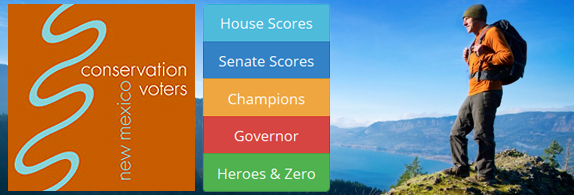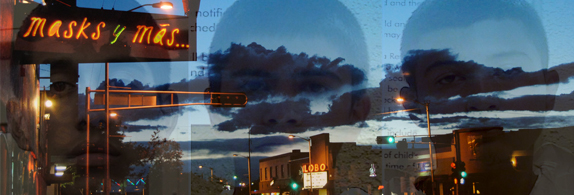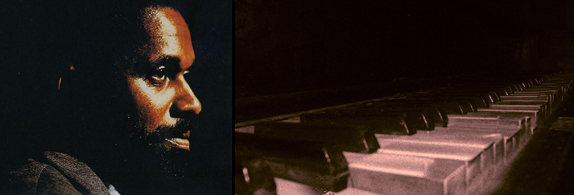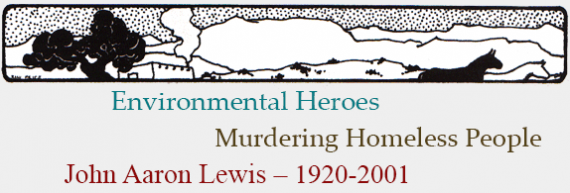Environmental Heroes

In a state like ours which has hardly ever met a polluter it didn’t want to coddle and spoil beyond redemption, I’m always heartened when the Conservation Voters of New Mexico (CVNM) comes out with its annual Conservation Scorecard. CVNM is a group that pulls no punches. The good guys and the bad guys are seen for who they really are.
The history of New Mexico’s environment is a depressing mess of botched pollution regulations often written by the polluters themselves who work in everything from mining and oil and gas extraction and conveyance to various forms of manufacturing and the military. Our state is literally riddled with contamination sites and events and truly horrific amounts and kinds of pollution.
The nation’s largest radioactive release, for instance, happened on the Navajo Reservation at a United Nuclear Corporation milling pond site near Church Rock NM, on July 16, 1979 when a holding dam broke releasing 93,000 million gallons of highly toxic radioactive waste that included the deadly poisonous polonium, and radioactive uranium and radium, as well as a thousand plus tons of solid radioactive waste. The whole thing flowed into the Puerco River and through Gallup, popping up manhole covers, and went all the way into Chandler, AZ some 80 miles distant.
And there had been a similar dam failure at the same site three years earlier with about half as much material released into the Puerco. When I was researching the spill for my book The Orphaned Land in 2010, there was hardly any mention of it on the internet. Now it has its own Wiki page. And it’s about time.
People I’ve talked to off the record say the Navajo Nation never had a Special Olympics competition before the Church Rock spill. The birth defects and developmental disabilities that followed the breech in the dam was devastating to many Navajo families and children. Navajo miners, as well as Acoma and Laguna Pueblo mine workers, suffered greatly, as have families from uranium mining regions in the Grants Mineral Belt west of Albuquerque since the first uranium boom in the l950s.
And now it’s almost common knowledge that we have a 24 million gallon jet fuel spill at Kirtland Air Force Base, that Los Alamos National Laboratories has some 2100 contamination sites, that Sandia Labs has some 400 such sites, and that sections of Albuquerque’s South Valley are the most polluted places in the city. Now we hear unconfirmed reports of some 50 million gallons of crude oil sitting on top of the aquifer around Hobbs. And that’s just a tiny sampling.
We also know that New Mexico has many thousands of devoted environmentalists and green organizations that have fought the good fight against polluters and desecraters of the land for decades, the CVNM being prominent among them. In its 2013-2014 Conservation Scorecard it lists the environmental records of every member of the New Mexico Legislature. It’s a fascinating list. There are only five senators with a 100% environmentally sound voting record – Cisco McSorley, Bill O’Neill, Nancy Rodriguez, Michael Sanchez, and Peter Wirth.
Members of the House with a 100% conservation voting record are Gail Chasey, Nate Cote, the late Stephen Easley, Brian Egolf, Miguel Garcia, Georgene Louis, Patricia Roybal Caballero, Jeff Steinborn, and Mimi Stewart.
These are names to remember and to be held in high esteem.
If you go to the CVNM website you’ll learn more about these environmental champions and about CVNM. You’ll also get a rundown on their analysis of voting records. In a section called “lowlight,” CVNM observes:
Although protecting the health of our communities and environment is important to New Mexicans across the entire political spectrum, that same commitment is not reflected by our elected officials in the Roundhouse. All too often votes are cast along predictably partisan lines. To the extent that there is crossover in partisan support for, or opposition to, environmental safeguards, the crossover generally consists of more conservative Democrats siding with Republicans against common sense protections.
CVNM goes on to comment that in other highly conservative states not all Republicans are against environmental protections and sound regulations, harkening back to the environmental ethic of Teddy Roosevelt and Richard Nixon.
CVNM then asks “When will Republican legislators embrace their party’s conservation heritage” in New Mexico? “When will clean air and water stop being fodder for partisan squabbles? For the sake of our children and grandchildren, we hope it will be soon.”
CVNM also gives Governor Martinez a “Grade: F” in a piece called “Foul Legacy: Susana Martinez and the Politics of Pollution.” It’s good to read other people saying what you’ve felt for so long – the present governor is the puppet of profit, profit made by neglecting and destroying the land, befouling water, and disregarding the labor value of others.
CVNM says it like it is. “Governor Martinez has repeatedly and aggressively championed polluting industries at the expense of the health and safety of New Mexicans.” The “Grade F” analysis concludes, “When it comes to safeguarding our air and water, it is difficult to imagine a governor with a more atrocious record than Susana Martinez.” Be sure to go to the CVA website and read this piece in its entirety.
Many of us searching for environmental sanity in public policy in our state have looked to the CVNW and its earlier avatars for a reasonable, data rich and effective way to lobby the legislature, a job the CVNM has always done with remarkable success. I’m not usually a joiner, but I’ve been a member of the CVA almost since it started. And if you aren’t one yet, give them look and see what you think.
Murdering Homeless People with Concrete Blocks

Waking up to the news that three young boys have been hunting and beating and sometimes murdering homeless people at night around Albuquerque, some 50 of them by one count, sent the city into an agitated depression. It was like learning about a horrendous natural catastrophe somewhere very nearby. We were nauseated and full of fear spiked by revulsion. It felt like a moral sinkhole had opened up in the middle of town. Many of us had no way to think about such a thing.
Clearly, however, we know that these are not the acts of sane people. They seem like the horrific wildings of children who behaved more like youngsters under the influence of mob hysteria than as willful and or even conscious perpetrators of atrocity. Whatever happens to these three boys, the stunned and outraged adult world must not treat them as faceless monsters of mob, but as individual children with individual situations and personal tragedies who are desperately in need of expert mental health counseling, treatment and long term care.
And now we read of the 27th killing by police in Albuquerque. The initial story has it that the deceased was a habitual criminal with outstanding warrants and a gun. Time will tell about the veracity of those early reports and if video cams were used and proper protocols were followed.
The heinousness of the boys’ crimes make our world seem even more sickening in the context of news that in Arizona a man executed by lethal injection for a double murder took two hours of gasping and tossing to die. Two hours!
Are the three young males who beat the homeless men to death somehow representative of the soul of our city and our times? Are the Arizona executioners symbols of what our world has become? Is there a connection between police violence in Albuquerque against the homeless and mentally ill and the sociopathological rampage of those three boys? We have heard that one or more of them had been homeless in the past, that one had contemplated or attempted suicide, that two had dropped out of middle school, and that one of them said he looked at himself in the mirror and saw the devil. We must assume that all have been victims of poverty, the abuses it can cause and exacerbate, and the aggravated neglect of the greater society.
I’m not one who thinks Albuquerque has lost its soul, or its heart, because of this. Nor can I say that the whole city is apathetic or in a state of psychotic denial just because its leadership is, particularly the mayor and the business elite who see no poverty, no violence, no homelessness and destitution, take no responsibility, and refuse to hear about or discuss the darker side of life in our city. To pin that on everyone is implying that we are only our leadership and that the rest of us are a mob of zombies. We’re a city of great heart, great soul, deep abiding religious conscience and spirituality, and, as some have pointed out, horrible denial. That is not unique to us in this country or this world.
It is, however, the moral responsibility of our leadership and the voting public to follow the courageousness of our social activists, our communities of faith and generosity and make conscious through open discussion and dialogue what we know to be true but what many of us can’t face and try to repress and forget – that we are a city plagued by vast and seemingly incurable poverty, joblessness, and desperation. That’s not all we are, of course. We are still the beautiful and creative oasis of culture, science and the arts that we have always been. But that can disguise the truth that many, tens of thousands or more, of our fellow citizens are suffering terribly.
What we don’t know in any detail, but what we validly suspect, is that such terrible economic conditions and the social and psychological tensions they produce have a profound impact on those who are predisposed to emotional and mental instability, like the three boys who murdered homeless people by smashing them with iron poles and cement blocks. We all react differently to such pressures.
We also hear reports that homeless people are the objects of harassment and violence all the time. And where there are many victims there are many abusers, not just those three boys. We’ve also heard that the homeless tend to be afraid of the police and don’t seek help because the long history of police violence against them.
We know so much and know so little.
But the mechanism described by psychologist Carl Jung is universally applicable. What you can’t make conscious becomes a dark shadow in your life, and this dark shadow sometimes becomes your ghastly fate.
As citizens of this world and this city, we owe it to our own humanity to try to understand the full circumstances of the individual lives of each of these violent children, and the impact of poverty on their individual psychologies, and not treat them like animals or demons we want to hide from, repress, deny, and bury alive in the dungeons of our prison system. We need to give them the best we have to understand them and to understand what the pressures they and so many other people are under in these grim economic times. Without our best efforts to understand, they will become part of our collective shadow and perhaps appear to us again as a terrible and still incomprehensible fate we might have avoided if we’d paid attention to the plight of others and made conscious in our lives the realities they face and to which they must adapt.
And at the very least, we need a sustained, long term citywide effort to ameliorate homelessness in Albuquerque, to feed children, and to develop a compassionate relationship between people down on their luck and the police who are meant to protect them from violence and abuse. We have the money, we have tons of food wasted every day, but our collective conscience is on hold, we have elected people who do not care. As anyone who has struggled with economic uncertainty, or any kind of emotional trouble, knows only too well, most of us are an accident, a personal tragedy, or lost job away from dangerous incapacity, fear induced incompetence, paralyzing hopelessness. We can’t wash our hands of those who suffer from economic injustice and are forced to deal with the violence on our streets, alone and afraid every night.
John Aaron Lewis – 1920-2001

The auditorium in the South Broadway Cultural Center is named after one of Albuquerque’s and New Mexico’s most brilliant creative minds and talents – John Lewis, pianist, educator, composer and leader of the Modern Jazz Quartet (MJQ), among the most famous of all jazz ensembles..
Every year now since 2001, the Cultural Center, sponsored by the Outpost Performance Space, has held a birthday celebration and concert for John Lewis. This May, the celebration was performed by the Tribute Trio, a group formed in 2010 to honor and perform the music of great jazz pianists. And John Lewis was surely one of the greatest.
I’ve spent the last couple of weeks during the New Mexico Jazz Festival driving around Albuquerque listening on my car CD player to an album by John Lewis and the MJQ recorded in Paris in l957 called “Afternoon in Paris.” It’s perhaps the coolest forty five minutes of music – both psychologically and aesthetically – I’ve ever heard, and I’ve heard it now dozens of times.
I’m interested in John Lewis because he grew up in Albuquerque around South Broadway and was educated in Albuquerque public schools and at the University of New Mexico. A legend in his time, he’s idolized, of course, by jazz lovers, but is certainly not a household name in Albuquerque or even at UNM. Although he died at 80 in 2001, it’s still possible to see YouTube film clips of him and the MJQ from l965 on, playing some of his most beloved compositions including Django and Afternoon in Paris. Watching the calm joy of his smile as he played is something I’ll return to over and over again.
John Lewis came to Albuquerque with his mother in l922 when he was two to live with his grandmother and great grandmother after his father and mother divorced. I don’t know more of his genealogy, but I’m going to try to track it down. He learned to play the piano from his aunt, and was apparently a prodigy. He played in a Boy Scout Band here, earned 50 cents a performance on Sunday mornings playing in various churches, and did stints in bars and hotels in the city, even learning to play Mexican songs and polkas. From his church experiences he became acquainted with forms of religious music. When he went to UNM he studied anthropology and music composition and history, and became a scholar of classical music, especially Bach. He was drafted into WWII in l942, but returned to UNM in l946 to finish his degree.
When he was 26, he had a chance to go to New York City. There he met Dizzy Gillespie, played with his big band, and worked on an advanced degree at the Manhattan School of Music. He was called the mastermind of the MJQ which he and vibraphonist Milt Jackson, bassist Ray Brown and drummer Kenny Clarke formed in the early 50s.
I may have a slight passing connection with them. They went on a European tour in 1956 and stayed on the continent, as far as I can tell, though l958, playing with French musicians and working to comprehend the evolution of “European classical music” as it worked its way through to emerge in the Jazz world of the south and of the African American diaspora into northern cities. The MJQ became internationally famous on that trip
I was in Paris as a 17 year old in l958. At the very least I was in the same town as John Lewis. And while I’m pretty sure I never heard him play, I knew the streets in the Latin Quarter on which he must have walked. Such are the gossamer associations of poets and cloud dwellers. When I found out that John Lewis and I grew up in the same town, albeit 50 years apart, my feelings of kinship and pride of place grew immeasurably.
In an exchange between John Ember and Shirley Griffith on People in America three years after John Lewis died, Ember described Lewis as the “musical director” of the MJQ. “He wrote and arranged all the music for the small group….[He] was responsible for the group’s sound and its identity. John Lewis was interested in jazz, blues and bebop, a music with a great deal of energy. Yet he was greatly influenced by his training in European classical music. Classical music is expressive and intense, but is also structured. He thought jazz should be presented the same way.”
Lewis and the MJQ had its cake and ate it too. The group worked in fugues and melodies that Lewis wrote, played from written scores, and they always kept room for improve “the group invented as it went along.”
In its obit of Lewis in 2001, the New York Times described him as a “Jazzman” who had a “gentle elegance.” During his memorial service at St. John the Divine, Ben Ratliff of the Times said that “as speakers ascended to the pulpit…to remember him, the picture they rendered was of a man gentle to the point of folksy in his manner and yet so precise in his work that he added up to an elegant riddle.” His friends saw him “as the embodiment of jazz’s totality, its mixture of down-home and the urbane.”
When the MJQ played a concert in Albuquerque in l971, I was working for the New Mexico Independent but I didn’t know about the concert. I’m still kicking myself for missing it. But I’ve made up for that. This June and July, John Lewis has been calming my nerves with his sumptuous cool and delicious reserve virtually every day in this time of wild violence and disheartening denial. His work and his life are the perfect antidote to cure the blues, replacing it with something so soulfully true the world just rides on cloud nine while it’s playing in your ear.
(Photo of Nob Hill by Aurora Michele, piano keys by el Buho nº30)




Responses to “Provincial Matters, 7-28-2014”